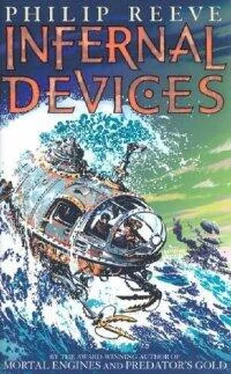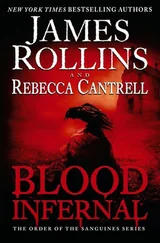Tom went with them, trying not to look too eager, reminding himself that Wren would probably not be here. He shuffled along among the other visitors, peering at a display of crab-cams and then at a limpet called Spider Baby that stood on a dais in the center of the hall. Whoever had put it there had given it a dramatic pose; it was rearing back on its four hind legs and waving its front feet in the air as if it were about to lash out at the visitors. Families posed in front of it to have their photographs taken, the children making scared faces, or sticking out their tongues at the looming machine.
Beyond the limpet, in a straw-lined cage, captive Lost Boys squatted and stared at the passing crowds. Sometimes one would fling himself at the bars, shouting abuse, and the visitors would scuttle away, frightened and delighted, while one of the burly attendants poked the savage with an electric prod. Tom felt sorry for the Lost Boys, and almost relieved that Wren was not among them.
Nearby, a pretty young woman in aquarium livery was pointing out details to a group of children. Tom waited until she had finished, then approached her. “Excuse me,” he asked, “could you tell me how many limpets were taken?”
The pretty young woman was really very pretty. Her smile almost dazzled Tom. “Nineteen in total, sir,” she said, “and three destroyed at sea.”
“And was one of them called the Autolycus?”
The smile faded. Flustered, the woman riffled through her exhibition notes. Nobody had ever asked her about a particular limpet before. “Let me see…” she muttered. “I believe… Oh, yes! The Autolycus was one of the first limpets we caught, way over in the western seas, far from the parasite lair.” Her smile returned. “She must have been swimming off on a burgling mission when we snapped her up…”
“And the crew?”
The young woman was still smiling, but her eyes were troubled; she was starting to wonder if Tom was some kind of weirdo. “You’d have to ask Mr. Shkin, sir. Mr. Nabisco Shkin. All the captives are property of the Shkin Corporation.”
“And what’s the Shkin Corporation?” asked Hester, who had just been told the same thing by a secondhand balloon salesman at the air harbor.
“Slaves,” said the man, spitting a black jet of tobacco juice onto the deck plate at his feet and winking at her. “All them boys and girls they fished up are all slaves now, and serves them right, I say.”
A slave, thought Hester as she strode away through the increasingly busy streets. The shadows of airships and balloon taxis slid over her as they poured into the air harbor to offload more cackling crowds of tourists. A slave. Hester shouldered a group of language students off the pavement. How was she going to break this to Tom? That his beloved little girl was cooped up in a slave hold somewhere, or enduring who knew what at the hands of cruel owners…
To make matters worse, she had learned that her plan of buying an airship would not work. Prices had rocketed since she’d last been aboard a city, and the gold that she had taken from Grimsby wouldn’t buy so much as a spare engine pod at the secondhand airship yards.
She spent some of it at a stall behind the harbor instead, buying a pair of jet-black sunglasses to hide her missing eye and a headdress of silver discs that more or less concealed the scar on her forehead. She bought a new veil too, and an ankle-length black coat with many buttons to replace the shabby thing she’d worn all the way from Anchorage. Walking on, she found her mood improving. She liked this city. She liked the sunshine and the crowds, the jangle of slot machines, the tatty facades of the hotels. She liked being among people who did not know her and could not guess what lay beneath her veil. She liked the handsome young aviators who smiled at her as she strode past, their eyes drawn to this mysterious woman with her hidden face and long, lean body. And—although she didn’t quite admit it to herself—she liked life without Wren. She was almost glad that the girl had got herself kidnapped.
She stopped to study a street plan and then crossed a footbridge over the Sea Pool and headed aft to the Old Steine. There was no sign of Tom at the tables outside the Pink Café. Hester considered having a coffee while she waited for him, then decided that she couldn’t afford one at Brighton prices. She wandered around the long curve of the Steine instead, looking at the shop fronts, until she came to one that stopped her short.
It was a shabby building that had once been a theater. A cheery pink sign above its door proclaimed THE NIMROD PENNYROYAL EXPERIENCE, and posters announced: RELIVE MAYOR PENNYROYAL’S ADVENTURES ON FIVE CONTINENTS AND A THOUSAND CITIES] EDUCATIONAL AND ENTERTAINING! In the window a waxwork of Pennyroyal, chained to the floor of a cardboard dungeon, raised and lowered its head, peering quizzically at a crescent-shaped blade that swung to and fro above it on a pendulum.
Mayor Pennyroyal? Hester had often wondered what had become of the fake explorer after he shot Tom and stole the Jenny Haniver. She had assumed that the gods would have punished him by now for all his lies and tricks; they’d had sixteen years to think of a suitable comeuppance, after all. Instead, they seemed to have rewarded him. Pennyroyal was alive. And Pennyroyal knew what she had done. She had told him herself, in the Aakiuqs’ smashed-up kitchen, while she was getting ready to murder Masgard and his Huntsmen.
She handed a bronze coin to the man at the ticket booth and went inside.
It seemed as though Brighton’s other visitors had found better ways of educating and entertaining themselves, for the Nimrod Pennyroyal Experience was almost deserted. There was a dusty museum smell, and another smell, tantalizing and out of place, that was even more familiar. Hester wandered past unimpressive artifacts in glass cases, past a reconstruction of an Ancient landfill site that Pennyroyal had once excavated. Paintings and waxwork dioramas showed Pennyroyal battling a bear, escaping from air pirates, and almost being sacrificed by a cult of Old Tech-worshipping female warriors—all scenes from Pennyroyal’s bestselling books, and all total fibs. Only one of the paintings meant anything to Hester. It showed Pennyroyal, sword in hand, fighting off a horde of savage Huntsmen, while at his side a beautiful young woman expired prettily. It was only after she had stared at the picture for a minute or more that Hester noticed the martyred girl wore an eye patch and had a fetching little scar on her cheek.
“Gods!” she said aloud. “Is that bimbo supposed to be me?”
Her voice sounded loud in the empty, echoey rooms. As it faded, Hester heard footsteps, and the man from the kiosk put his head round the door and asked, “Everything all right, madam?”
Hester nodded, too angry to speak.
“Magnificent painting, eh?” the curator said. He was a friendly man, middle-aged, with a few strands of sandy hair combed carefully across his bald head. He came and stood next to Hester and beamed proudly at the picture. “It’s inspired by the closing chapters of Predator’s Gold, in which His Worship does battle with the Huntsmen of Arkangel.”
“Who’s the girl?” asked Hester.
“You haven’t read Predator’s Gold?” asked the man, surprised. “That is Hester Shaw, the aviatrix who sells Anchorage to the Huntsmen. She redeems herself, the poor creature, by dying at Pennyroyal’s side, cut down by the chief of the Huntsmen, Piotr Masgard.”
Hester turned away quickly, climbing a dusty metal staircase toward the upper floor of the museum, barely seeing the displays she passed, her head filled with panicky, racing thoughts. Everything was ruined! Pennyroyal didn’t just know what she’d done, he’d written a book about it! There were paintings! Even if Pennyroyal had twisted the facts, the truth was still there, in black and white on the pages of his book. Hester Shaw had sold Anchorage to the Huntsmen. And when Tom found out…
Читать дальше












